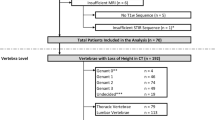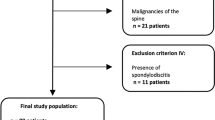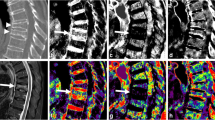Abstract
Purpose
To compare the diagnostic performance of different reconstruction algorithms of single-source dual-energy computed tomography (DECT) for the detection of bone marrow lesions (BML) in patients with vertebral compression fracture using MRI as the standard of reference.
Material and Methods
Seventeen patients with an age over 50 who underwent single-source DECT of the spine were included. The raw data (RD) were reconstructed using filtered back-projection (FBP) and iterative reconstruction (IR) with three iteration levels (IR1–IR3). Bone marrow images were generated using a three-material decomposition (3MD) and a two-material decomposition (2MD) algorithm and an RD-based approach. Three blinded readers scored the images for image quality and the presence of bone marrow lesions (BML). Only vertebrae with height loss were included. The signal-to-noise ratio (SNR) and contrast-to-noise ratio (CNR) were calculated. The different reconstructions were compared using Dunn’s multiple comparison test.
Results
Thirty-nine vertebrae were included. IR(1–3) showed superior sensitivity (87.5%) compared to FBP (75%) using 3MD but was comparable to RD (83.3%). All 2MD images were inferior (sensitivity < 38%). The image quality score was significantly higher for 3MD-IR(1–3) compared to 3MD-FBP (p < 0.0001) and all 2MD data sets (p < 0.03). This pattern was also supported by the SNR and CNR measurements. RD showed no significant improvement compared to IR.
Conclusion
The image quality of bone marrow images acquired with DECT can be improved by using IR compared with FBP. RD-based reconstruction does not offer significant improvement over image data-based reconstruction. 2MD algorithms are not suitable for BML detection.




Similar content being viewed by others
References
Ai S, Qu M, Glazebrook KN, Liu Y, Rhee PC, Leng S, et al. Use of dual-energy CT and virtual non-calcium techniques to evaluate post-traumatic bone bruises in knees in the subacute setting. Skelet Radiol. 2014;43(9):1289–95. https://doi.org/10.1007/s00256-014-1913-7.
Guggenberger R, Gnannt R, Hodler J, Krauss B, Wanner GA, Csuka E, et al. Diagnostic performance of dual-energy CT for the detection of traumatic bone marrow lesions in the ankle: comparison with MR imaging. Radiology. 2012;264(1):164–73. https://doi.org/10.1148/radiol.12112217.
Poort LJ, Stadler AAR, Ludlage JHB, Hoebers FJP, Kessler PAWH, Postma AA. Detection of bone marrow edema pattern with dual-energy computed tomography of the pig mandible treated with radiotherapy and surgery compared with magnetic resonance imaging. J Comput Assist Tomogr. 2017;41(4):553–8. https://doi.org/10.1097/rct.0000000000000559.
J-x C, Wang Y-m, Kong X-q, Yang C, Wang P. Good interrater reliability of a new grading system in detecting traumatic bone marrow lesions in the knee by dual energy CT virtual non-calcium images. Eur J Radiol. 2015;84(6):1109–15. https://doi.org/10.1016/j.ejrad.2015.03.003.
Dareez NM, Dahlslett KH, Engesland E, Lindland ES. Scaphoid fracture: bone marrow edema detected with dual-energy CT virtual non-calcium images and confirmed with MRI. Skelet Radiol. 2017;46(12):1753–6. https://doi.org/10.1007/s00256-017-2730-6.
Kosmala A, Weng AM, Heidemeier A, Krauss B, Knop S, Bley TA, et al. Multiple myeloma and dual-energy CT: diagnostic accuracy of virtual noncalcium technique for detection of bone marrow infiltration of the spine and pelvis. Radiology. 2018;286(1):205–13. https://doi.org/10.1148/radiol.2017170281.
Diekhoff T, Hermann KG, Pumberger M, Hamm B, Putzier M, Fuchs M. Dual-energy CT virtual non-calcium technique for detection of bone marrow edema in patients with vertebral fractures: a prospective feasibility study on a single- source volume CT scanner. Eur J Radiol. 2017;87:59–65. https://doi.org/10.1016/j.ejrad.2016.12.008.
Karaca L, Yuceler Z, Kantarci M, Çakır M, Sade R, Calıkoglu C, et al. The feasibility of dual-energy CT in differentiation of vertebral compression fractures. Br J Radiol. 2016;89(1057):20150300. https://doi.org/10.1259/bjr.20150300.
Petritsch B, Kosmala A, Weng AM, Krauss B, Heidemeier A, Wagner R, et al. Vertebral compression fractures: third-generation dual-energy CT for detection of bone marrow edema at visual and quantitative analyses. Radiology. 2017;284(1):161–8. https://doi.org/10.1148/radiol.2017162165.
Bierry G, Venkatasamy A, Kremer S, Dosch J-C, Dietemann J-L. Dual-energy CT in vertebral compression fractures: performance of visual and quantitative analysis for bone marrow edema demonstration with comparison to MRI. Skelet Radiol. 2014;43(4):485–92. https://doi.org/10.1007/s00256-013-1812-3.
Diekhoff T, Engelhard N, Fuchs M, Pumberger M, Putzier M, Mews J, et al. Single-source dual-energy computed tomography for the assessment of bone marrow oedema in vertebral compression fractures: a prospective diagnostic accuracy study. Eur Radiol. 2018. https://doi.org/10.1007/s00330-018-5568-y.
Omoumi P, Becce F, Racine D, Ott JG, Andreisek G, Verdun FR. Dual-energy CT: basic principles, technical approaches, and applications in musculoskeletal imaging (part 1). Semin Musculoskelet Radiol. 2015;19(5):431–7. https://doi.org/10.1055/s-0035-1569253.
Omoumi P, Verdun FR, Guggenberger R, Andreisek G, Becce F. Dual-energy CT: basic principles, technical approaches, and applications in musculoskeletal imaging (part 2). Semin Musculoskelet Radiol. 2015;19(5):438–45. https://doi.org/10.1055/s-0035-1569252.
Pache G, Krauss B, Strohm P, Saueressig U, Blanke P, Bulla S, et al. Dual-energy CT virtual noncalcium technique: detecting posttraumatic bone marrow lesions—feasibility study. Radiology. 2010;256(2):617–24. https://doi.org/10.1148/radiol.10091230.
Reagan AC, Mallinson PI, O’Connell T, McLaughlin PD, Krauss B, Munk PL, et al. Dual-energy computed tomographic virtual noncalcium algorithm for detection of bone marrow edema in acute fractures: early experiences. J Comput Assist Tomogr. 2014;38(5):802–5. https://doi.org/10.1097/rct.0000000000000107.
Glazebrook KN, Brewerton LJ, Leng S, Carter RE, Rhee PC, Murthy NS, et al. Case–control study to estimate the performance of dual-energy computed tomography for anterior cruciate ligament tears in patients with history of knee trauma. Skelet Radiol. 2014;43(3):297–305. https://doi.org/10.1007/s00256-013-1784-3.
Winklehner A, Karlo C, Puippe G, Schmidt B, Flohr T, Goetti R, et al. Raw data-based iterative reconstruction in body CTA: evaluation of radiation dose saving potential. Eur Radiol. 2011;21(12):2521–6.
Potter CA, Sodickson AD. Dual-energy CT in emergency neuroimaging: added value and novel applications. Radiographics. 2016;36(7):2186–98. https://doi.org/10.1148/rg.2016160069.
Alshamari M, Geijer M, Norrman E, Lidén M, Krauss W, Jendeberg J, et al. Impact of iterative reconstruction on image quality of low-dose CT of the lumbar spine. Acta Radiol. 2017;58(6):702–9. https://doi.org/10.1177/0284185116669870.
Becce F, Ben Salah Y, Verdun FR, Vande Berg BC, Lecouvet FE, Meuli R, et al. Computed tomography of the cervical spine: comparison of image quality between a standard-dose and a low-dose protocol using filtered back-projection and iterative reconstruction. Skelet Radiol. 2013;42(7):937–45. https://doi.org/10.1007/s00256-013-1576-9.
Gervaise A, Osemont B, Lecocq S, Noel A, Micard E, Felblinger J, et al. CT image quality improvement using adaptive iterative dose reduction with wide-volume acquisition on 320-detector CT. Eur Radiol. 2012;22(2):295–301. https://doi.org/10.1007/s00330-011-2271-7.
Patro SN, Chakraborty S, Sheikh A. The use of adaptive statistical iterative reconstruction (ASiR) technique in evaluation of patients with cervical spine trauma: impact on radiation dose reduction and image quality. Br J Radiol. 2016;89(1060):20150082. https://doi.org/10.1259/bjr.20150082.
Vaniqui A, LEJR S, Almeida IP, Bvd H, Podesta M, Verhaegen F. The effect of different image reconstruction techniques on pre-clinical quantitative imaging and dual-energy CT. Br J Radiol. 2019;92(1095):20180447.
Li M, Qu Y, Song B. Meta-analysis of dual-energy computed tomography virtual non-calcium imaging to detect bone marrow edema. Eur J Radiol. 2017;95:124–9. https://doi.org/10.1016/j.ejrad.2017.08.005.
Suh CH, Yun SJ, Jin W, Lee SH, Park SY, Ryu CW. Diagnostic performance of dual-energy CT for the detection of bone marrow oedema: a systematic review and meta-analysis. Eur Radiol. 2018. https://doi.org/10.1007/s00330-018-5411-5.
Kuno H, Sekiya K, Chapman MN, Sakai O. Miscellaneous and emerging applications of dual-energy computed tomography for the evaluation of intracranial pathology. Neuroimaging Clin N Am. 2017;27(3):411–27. https://doi.org/10.1016/j.nic.2017.03.005.
Ma G, Yu Y, Duan H, Dou Y, Jia Y, Zhang X, et al. Subtraction CT angiography in head and neck with low radiation and contrast dose dual-energy spectral CT using rapid kV-switching technique. Br J Radiol. https://doi.org/10.1259/bjr.20170631.
Naruto N, Tannai H, Nishikawa K, Yamagishi K, Hashimoto M, Kawabe H, et al. Dual-energy bone removal computed tomography (BRCT): preliminary report of efficacy of acute intracranial hemorrhage detection. Emerg Radiol. 2018;25(1):29–33. https://doi.org/10.1007/s10140-017-1558-7.
Naruto N, Itoh T, Noguchi K. Dual energy computed tomography for the head. Jpn J Radiol. 2018;36(2):69–80. https://doi.org/10.1007/s11604-017-0701-4.
von Elm E, Altman DG, Egger M, Pocock SJ, Gøtzsche PC, Vandenbroucke JP. The strengthening the reporting of observational studies in epidemiology (STROBE) statement: guidelines for reporting observational studies. Lancet. 2007;370(9596):1453–7. https://doi.org/10.1016/S0140-6736(07)61602-X.
Acknowledgements
Robert Roehle kindly provided statistical advice for this study.
Author information
Authors and Affiliations
Corresponding author
Ethics declarations
All patients gave written informed consent. The study was approved by the institutional review board. IRB approval was waived due to the retrospective design of this study.
Conflict of interest
The authors declare that they have no conflict(s) of interest.
Additional information
Publisher’s note
Springer Nature remains neutral with regard to jurisdictional claims in published maps and institutional affiliations.
Rights and permissions
About this article
Cite this article
Engelhard, N., Hermann, K., Greese, J. et al. Single-source dual-energy computed tomography for the detection of bone marrow lesions: impact of iterative reconstruction and algorithms. Skeletal Radiol 49, 765–772 (2020). https://doi.org/10.1007/s00256-019-03330-w
Received:
Revised:
Accepted:
Published:
Issue Date:
DOI: https://doi.org/10.1007/s00256-019-03330-w




